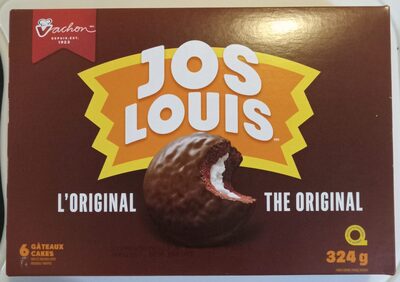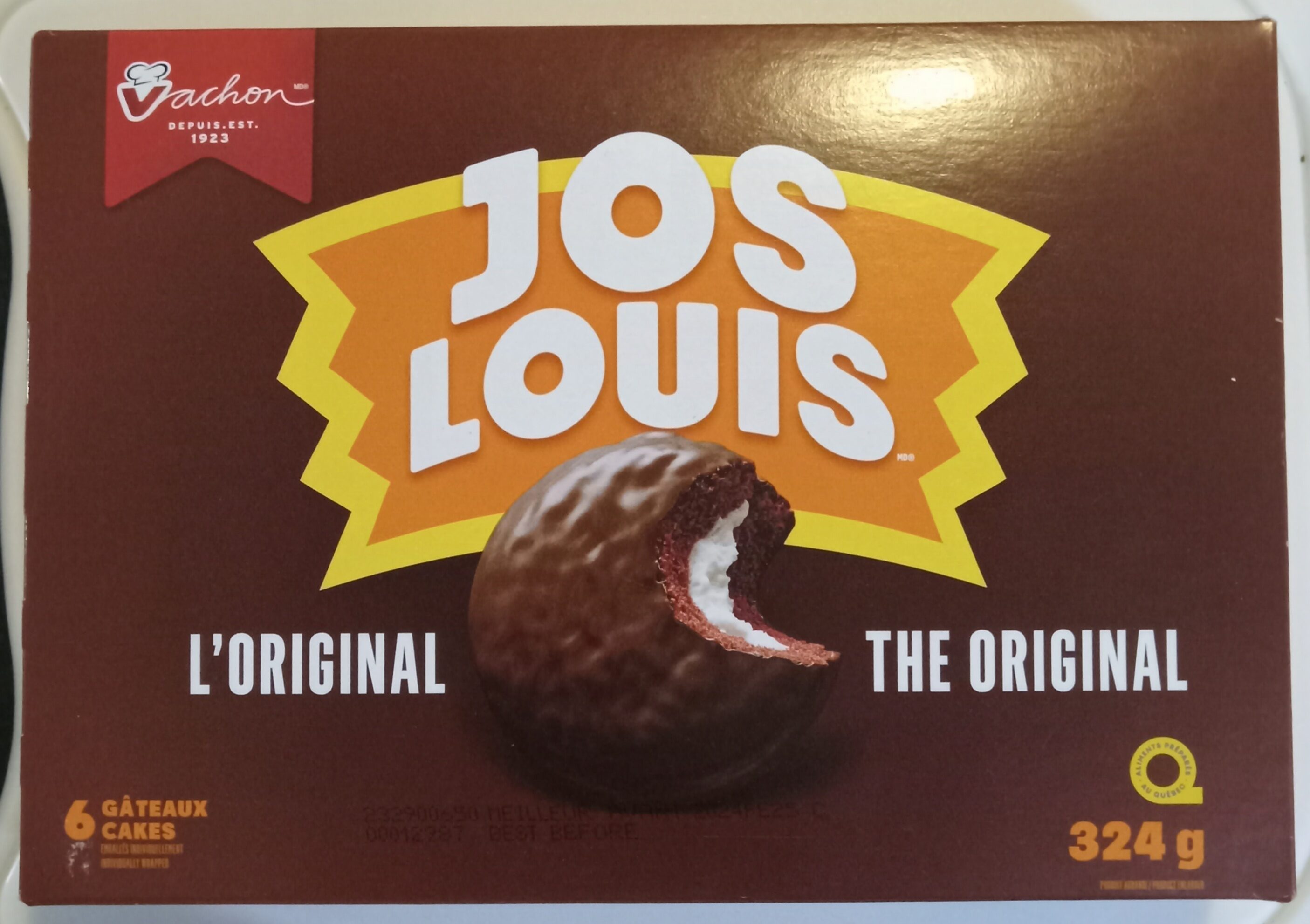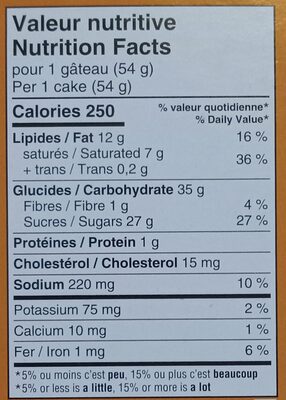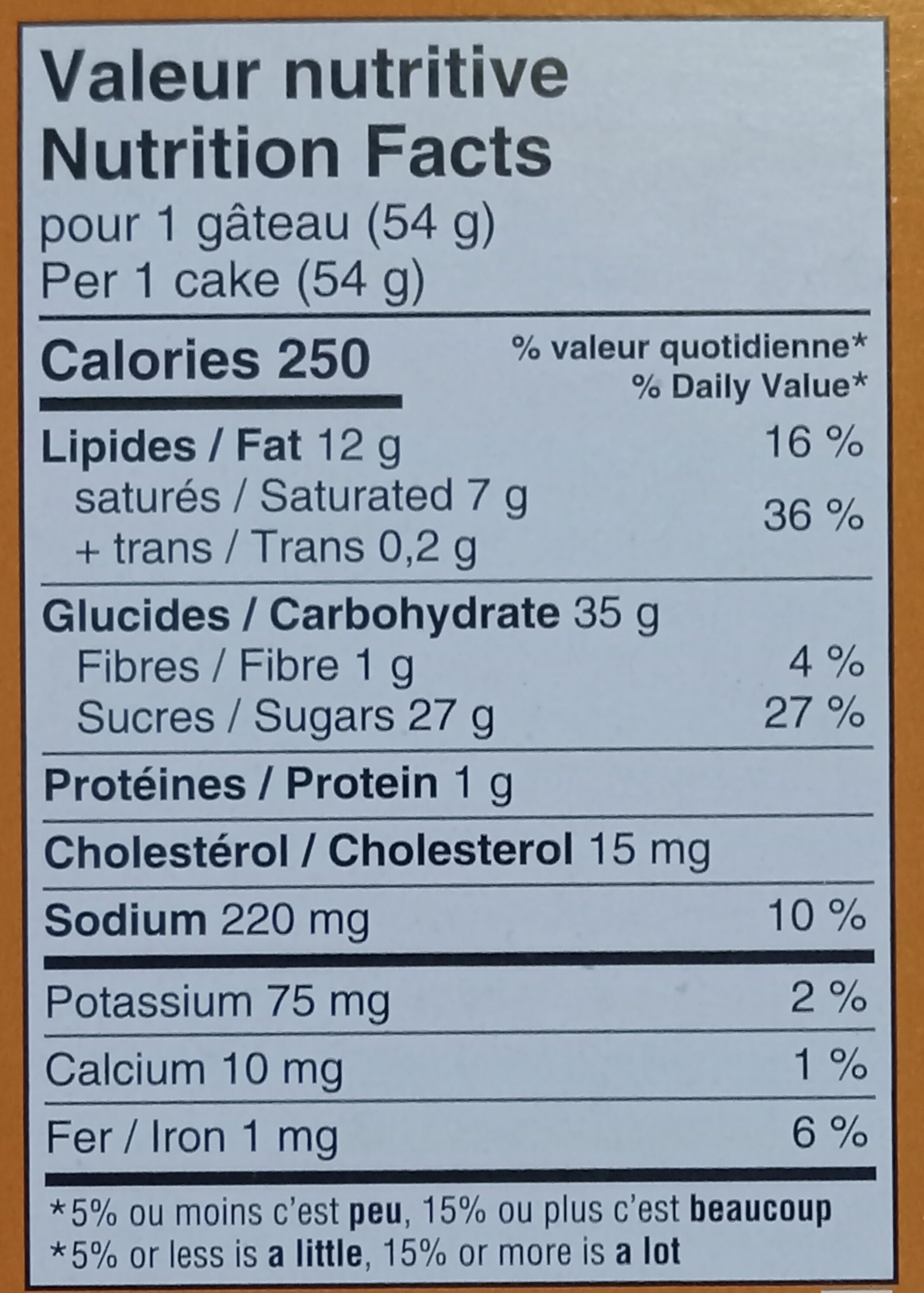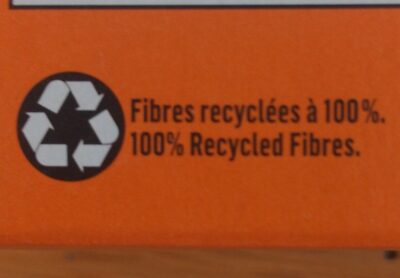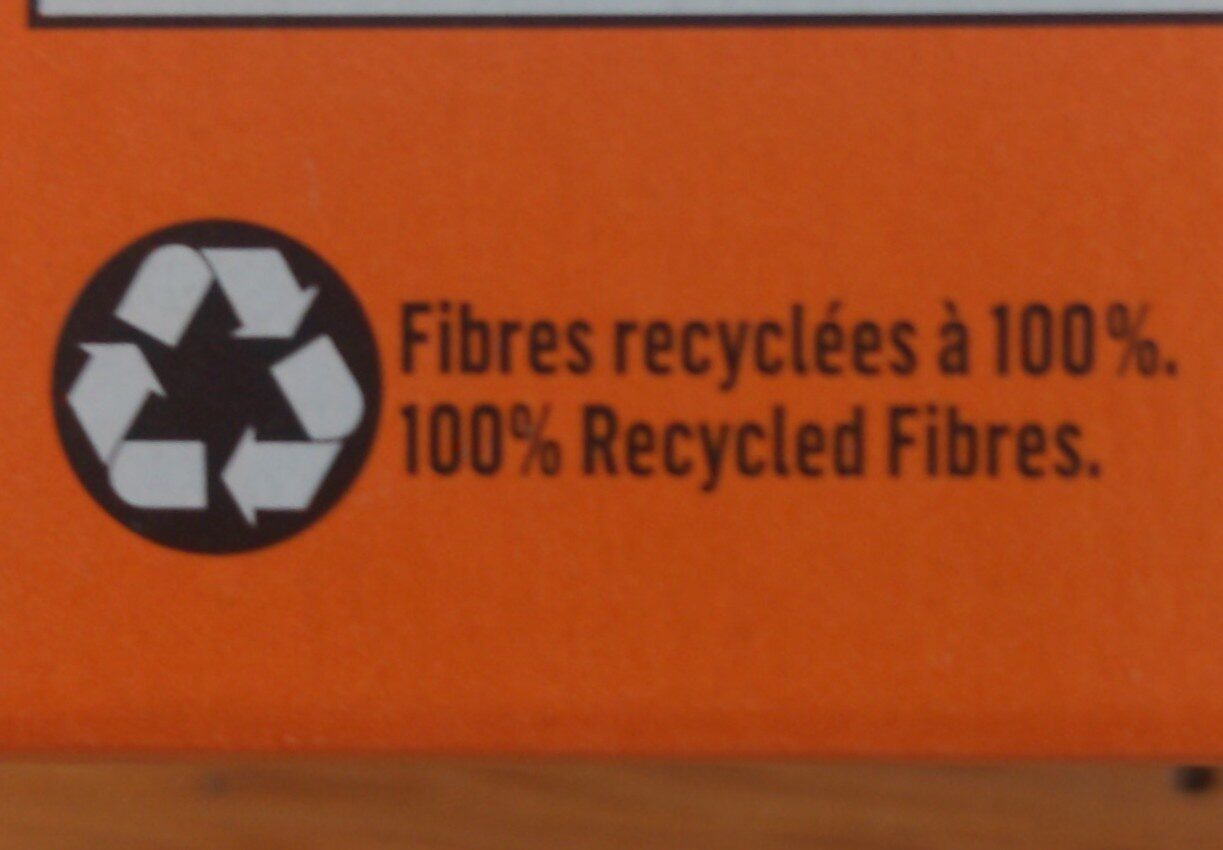Help us make food transparency the norm!
As a non-profit organization, we depend on your donations to continue informing consumers around the world about what they eat.
The food revolution starts with you!
Jos Louis - Vachon - 324 g
Jos Louis - Vachon - 324 g
This product page is not complete. You can help to complete it by editing it and adding more data from the photos we have, or by taking more photos using the app for Android or iPhone/iPad. Thank you!
×
Barcode: 0060737056008 (EAN / EAN-13) 060737056008 (UPC / UPC-A)
Quantity: 324 g
Brands: Vachon
Categories: Snacks, Sweet snacks, Biscuits and cakes, Cakes
Labels, certifications, awards: Aliments Prepares au Quebec
Link to the product page on the official site of the producer: https://www.vachon.com/marque/jos-louis
Stores: Amazon.ca, Real Canadian Superstore
Countries where sold: Canada
Matching with your preferences
Health
Ingredients
-
42 ingredients
Sugars (sugar, glucose), Enriched wheat flour, Hydrogenated palm and/or palm kernel oils, Vegetable oil, Liquid whole eggs, Glycerin, Cocoa, Water, Modified palm and palm kernel oils, Liquid egg whites, Baking powder, Salt, Propylene glycol, Modified milk ingredients, Soy lecithin, Soy protein, Sorbitan monostearate, Modified corn starch, Baking soda, Mono - and di-glycerides, Guar gum, Potassium sorbate, Polysorbate 60, Cellulose gum, Corn starch, Xanthan gum, Sorbic acid, Sodium bisulphate, Sodium acid pyrophosphate, Sorbitan tristearate, Acacia gum, Polysorbate 65, Potato starch, Tapioca starch, Natural and artificial flavour, Allura red, Tartrazine, Brilliant blue FCF.Allergens: GlutenTraces: Nuts, Peanuts
Food processing
-
Ultra processed foods
Elements that indicate the product is in the 4 - Ultra processed food and drink products group:
- Additive: E102 - Tartrazine
- Additive: E129 - Allura red
- Additive: E133 - Brilliant blue FCF
- Additive: E322 - Lecithins
- Additive: E412 - Guar gum
- Additive: E414 - Acacia gum
- Additive: E415 - Xanthan gum
- Additive: E422 - Glycerol
- Additive: E435 - Polyoxyethylene sorbitan monostearate
- Additive: E436 - Polyoxyethylene sorbitan tristearate
- Additive: E450 - Diphosphates
- Additive: E466 - Sodium carboxy methyl cellulose
- Ingredient: Flavouring
- Ingredient: Glucose
Food products are classified into 4 groups according to their degree of processing:
- Unprocessed or minimally processed foods
- Processed culinary ingredients
- Processed foods
- Ultra processed foods
The determination of the group is based on the category of the product and on the ingredients it contains.
Additives
-
E102 - Tartrazine
Tartrazine: Tartrazine is a synthetic lemon yellow azo dye primarily used as a food coloring. It is also known as E number E102, C.I. 19140, FD&C Yellow 5, Acid Yellow 23, Food Yellow 4, and trisodium 1--4-sulfonatophenyl--4--4-sulfonatophenylazo--5-pyrazolone-3-carboxylate-.Tartrazine is a commonly used color all over the world, mainly for yellow, and can also be used with Brilliant Blue FCF -FD&C Blue 1, E133- or Green S -E142- to produce various green shades.Source: Wikipedia
-
E129 - Allura red
Allura Red AC: Allura Red AC is a red azo dye that goes by several names, including FD&C Red 40. It is used as a food dye and has the E number E129. It is usually supplied as its red sodium salt, but can also be used as the calcium and potassium salts. These salts are soluble in water. In solution, its maximum absorbance lies at about 504 nm.Source: Wikipedia
-
E133 - Brilliant blue FCF
Brilliant Blue FCF: Brilliant Blue FCF -Blue 1- is an organic compound classified as a triarylmethane dye and a blue azo dye, reflecting its chemical structure. Known under various commercial names, it is a colorant for foods and other substances. It is denoted by E number E133 and has a color index of 42090. It has the appearance of a blue powder. It is soluble in water, and the solution has a maximum absorption at about 628 nanometers.Source: Wikipedia
-
E200 - Sorbic acid
Sorbic acid: Sorbic acid, or 2‚4-hexadienoic acid, is a natural organic compound used as a food preservative. It has the chemical formula CH3-CH-4CO2H. It is a colourless solid that is slightly soluble in water and sublimes readily. It was first isolated from the unripe berries of the Sorbus aucuparia -rowan tree-, hence its name.Source: Wikipedia
-
E202 - Potassium sorbate
Potassium sorbate (E202) is a synthetic food preservative commonly used to extend the shelf life of various food products.
It works by inhibiting the growth of molds, yeast, and some bacteria, preventing spoilage. When added to foods, it helps maintain their freshness and quality.
Some studies have shown that when combined with nitrites, potassium sorbate have genotoxic activity in vitro. However, potassium sorbate is generally recognized as safe (GRAS) by regulatory authorities.
-
E322 - Lecithins
Lecithins are natural compounds commonly used in the food industry as emulsifiers and stabilizers.
Extracted from sources like soybeans and eggs, lecithins consist of phospholipids that enhance the mixing of oil and water, ensuring smooth textures in various products like chocolates, dressings, and baked goods.
They do not present any known health risks.
-
E322i - Lecithin
Lecithins are natural compounds commonly used in the food industry as emulsifiers and stabilizers.
Extracted from sources like soybeans and eggs, lecithins consist of phospholipids that enhance the mixing of oil and water, ensuring smooth textures in various products like chocolates, dressings, and baked goods.
They do not present any known health risks.
-
E412 - Guar gum
Guar gum (E412) is a natural food additive derived from guar beans.
This white, odorless powder is valued for its remarkable thickening and stabilizing properties, making it a common ingredient in various food products, including sauces, dressings, and ice creams.
When used in moderation, guar gum is considered safe for consumption, with no known adverse health effects.
-
E414 - Acacia gum
Gum arabic: Gum arabic, also known as acacia gum, arabic gum, gum acacia, acacia, Senegal gum and Indian gum, and by other names, is a natural gum consisting of the hardened sap of various species of the acacia tree. Originally, gum arabic was collected from Acacia nilotica which was called the "gum arabic tree"; in the present day, gum arabic is collected from acacia species, predominantly Acacia senegal and Vachellia -Acacia- seyal; the term "gum arabic" does not indicate a particular botanical source. In a few cases so‐called "gum arabic" may not even have been collected from Acacia species, but may originate from Combretum, Albizia or some other genus. Producers harvest the gum commercially from wild trees, mostly in Sudan -80%- and throughout the Sahel, from Senegal to Somalia—though it is historically cultivated in Arabia and West Asia. Gum arabic is a complex mixture of glycoproteins and polysaccharides. It is the original source of the sugars arabinose and ribose, both of which were first discovered and isolated from it, and are named after it. Gum arabic is soluble in water. It is edible, and used primarily in the food industry as a stabilizer, with EU E number E414. Gum arabic is a key ingredient in traditional lithography and is used in printing, paint production, glue, cosmetics and various industrial applications, including viscosity control in inks and in textile industries, though less expensive materials compete with it for many of these roles. While gum arabic is now produced throughout the African Sahel, it is still harvested and used in the Middle East.Source: Wikipedia
-
E415 - Xanthan gum
Xanthan gum (E415) is a natural polysaccharide derived from fermented sugars, often used in the food industry as a thickening and stabilizing agent.
This versatile food additive enhances texture and prevents ingredient separation in a wide range of products, including salad dressings, sauces, and gluten-free baked goods.
It is considered safe for consumption even at high intake amounts.
-
E422 - Glycerol
Glycerol: Glycerol -; also called glycerine or glycerin; see spelling differences- is a simple polyol compound. It is a colorless, odorless, viscous liquid that is sweet-tasting and non-toxic. The glycerol backbone is found in all lipids known as triglycerides. It is widely used in the food industry as a sweetener and humectant and in pharmaceutical formulations. Glycerol has three hydroxyl groups that are responsible for its solubility in water and its hygroscopic nature.Source: Wikipedia
-
E450 - Diphosphates
Diphosphates (E450) are food additives often utilized to modify the texture of products, acting as leavening agents in baking and preventing the coagulation of canned food.
These salts can stabilize whipped cream and are also found in powdered products to maintain their flow properties. They are commonly present in baked goods, processed meats, and soft drinks.
Derived from phosphoric acid, they're part of our daily phosphate intake, which often surpasses recommended levels due to the prevalence of phosphates in processed foods and drinks.
Excessive phosphate consumption is linked to health issues, such as impaired kidney function and weakened bone health. Though diphosphates are generally regarded as safe when consumed within established acceptable daily intakes, it's imperative to monitor overall phosphate consumption to maintain optimal health.
-
E466 - Sodium carboxy methyl cellulose
Carboxymethyl cellulose: Carboxymethyl cellulose -CMC- or cellulose gum or tylose powder is a cellulose derivative with carboxymethyl groups --CH2-COOH- bound to some of the hydroxyl groups of the glucopyranose monomers that make up the cellulose backbone. It is often used as its sodium salt, sodium carboxymethyl cellulose.Source: Wikipedia
-
E500 - Sodium carbonates
Sodium carbonates (E500) are compounds commonly used in food preparation as leavening agents, helping baked goods rise by releasing carbon dioxide when they interact with acids.
Often found in baking soda, they regulate the pH of food, preventing it from becoming too acidic or too alkaline. In the culinary world, sodium carbonates can also enhance the texture and structure of foods, such as noodles, by modifying the gluten network.
Generally recognized as safe, sodium carbonates are non-toxic when consumed in typical amounts found in food.
-
E500ii - Sodium hydrogen carbonate
Sodium hydrogen carbonate, also known as E500ii, is a food additive commonly used as a leavening agent.
When added to recipes, it releases carbon dioxide gas upon exposure to heat or acids, causing dough to rise and resulting in a light, fluffy texture in baked goods.
It is generally recognized as safe (GRAS) by regulatory authorities when used in appropriate quantities and poses no significant health risks when consumed in typical food applications.
-
E514 - Sodium sulphates
Sodium sulfate: Sodium sulfate -also known as sodium sulphate or sulfate of soda- is the inorganic compound with formula Na2SO4 as well as several related hydrates. All forms are white solids that are highly soluble in water. With an annual production of 6 million tonnes, the decahydrate is a major commodity chemical product. It is mainly used for the manufacture of detergents and in the kraft process of paper pulping.Source: Wikipedia
-
E514ii - Sodium hydrogen sulphate
Sodium sulfate: Sodium sulfate -also known as sodium sulphate or sulfate of soda- is the inorganic compound with formula Na2SO4 as well as several related hydrates. All forms are white solids that are highly soluble in water. With an annual production of 6 million tonnes, the decahydrate is a major commodity chemical product. It is mainly used for the manufacture of detergents and in the kraft process of paper pulping.Source: Wikipedia
Ingredients analysis
-
Palm oil
Ingredients that contain palm oil: Palm oil, Hydrogenated palm kernel oil, Palm oil
-
Non-vegan
Non-vegan ingredients: Liquid whole egg, Liquid egg white, Modified milk ingredientsSome ingredients could not be recognized.
We need your help!
You can help us recognize more ingredients and better analyze the list of ingredients for this product and others:
- Edit this product page to correct spelling mistakes in the ingredients list, and/or to remove ingredients in other languages and sentences that are not related to the ingredients.
- Add new entries, synonyms or translations to our multilingual lists of ingredients, ingredient processing methods, and labels.
If you would like to help, join the #ingredients channel on our Slack discussion space and/or learn about ingredients analysis on our wiki. Thank you!
-
Vegetarian status unknown
Unrecognized ingredients: fr:huiles-de-palmiste-modifiees, fr:poudre-a-pate, fr:monostearate-de-sorbitan, fr:mono-et-diglycerides, E514ii, fr:tristearate-de-sorbitanSome ingredients could not be recognized.
We need your help!
You can help us recognize more ingredients and better analyze the list of ingredients for this product and others:
- Edit this product page to correct spelling mistakes in the ingredients list, and/or to remove ingredients in other languages and sentences that are not related to the ingredients.
- Add new entries, synonyms or translations to our multilingual lists of ingredients, ingredient processing methods, and labels.
If you would like to help, join the #ingredients channel on our Slack discussion space and/or learn about ingredients analysis on our wiki. Thank you!
-
Details of the analysis of the ingredients
We need your help!
Some ingredients could not be recognized.
We need your help!
You can help us recognize more ingredients and better analyze the list of ingredients for this product and others:
- Edit this product page to correct spelling mistakes in the ingredients list, and/or to remove ingredients in other languages and sentences that are not related to the ingredients.
- Add new entries, synonyms or translations to our multilingual lists of ingredients, ingredient processing methods, and labels.
If you would like to help, join the #ingredients channel on our Slack discussion space and/or learn about ingredients analysis on our wiki. Thank you!
fr: Sucres (sucre, glucose), Farine de blé enrichie, Huiles de palme, Huiles de palmiste hydrogénées, Huile végétale, Œufs entiers liquides, Glycérine, Cacao, Eau, Huiles de palme, Huiles de palmiste modifiées, Blancs d'œufs liquides, Poudre à pâte, Sel, Propylène glycol, Substances laitières modifiées, Lécithine de soya, Protéine de soya, Monostéarate de sorbitan, Fécule de maïs modifié, Bicarbonate de soude, mono- et diglycérides, Gomme de guar, Sorbate de potassium, Polysorbate 60, Gomme de cellulose, Fécule de maïs, Gomme xanthane, Acide sorbique, Bisulfate de sodium, Pyrophosphate acide de sodium, Tristéarate de sorbitan, Gomme d'acacia, Polysorbate 65, Fécule de pomme de terre, Fécule de tapioca, Arôme naturel et artificiel, Rouge allura, Tartrazine, Bleu brillant FCF- Sucres -> en:sugar - vegan: yes - vegetarian: yes - ciqual_proxy_food_code: 31016 - percent_min: 2.5 - percent_max: 100
- sucre -> en:sugar - vegan: yes - vegetarian: yes - ciqual_proxy_food_code: 31016 - percent_min: 1.25 - percent_max: 100
- glucose -> en:glucose - vegan: yes - vegetarian: yes - ciqual_proxy_food_code: 31016 - percent_min: 0 - percent_max: 50
- Farine de blé enrichie -> en:fortified-wheat-flour - vegan: yes - vegetarian: yes - ciqual_proxy_food_code: 9410 - percent_min: 0 - percent_max: 50
- Huiles de palme -> en:palm-oil - vegan: yes - vegetarian: yes - from_palm_oil: yes - ciqual_food_code: 16129 - percent_min: 0 - percent_max: 33.3333333333333
- Huiles de palmiste hydrogénées -> en:hydrogenated-palm-kernel-oil - vegan: yes - vegetarian: yes - from_palm_oil: yes - percent_min: 0 - percent_max: 25
- Huile végétale -> en:vegetable-oil - vegan: yes - vegetarian: yes - from_palm_oil: maybe - percent_min: 0 - percent_max: 20
- Œufs entiers liquides -> en:liquid-whole-egg - vegan: no - vegetarian: yes - ciqual_food_code: 22000 - percent_min: 0 - percent_max: 16.6666666666667
- Glycérine -> en:e422 - vegan: maybe - vegetarian: maybe - percent_min: 0 - percent_max: 14.2857142857143
- Cacao -> en:cocoa - vegan: yes - vegetarian: yes - ciqual_proxy_food_code: 18100 - percent_min: 0 - percent_max: 12.5
- Eau -> en:water - vegan: yes - vegetarian: yes - ciqual_food_code: 18066 - percent_min: 0 - percent_max: 11.1111111111111
- Huiles de palme -> en:palm-oil - vegan: yes - vegetarian: yes - from_palm_oil: yes - ciqual_food_code: 16129 - percent_min: 0 - percent_max: 10
- Huiles de palmiste modifiées -> fr:huiles-de-palmiste-modifiees - percent_min: 0 - percent_max: 9.09090909090909
- Blancs d'œufs liquides -> en:liquid-egg-white - vegan: no - vegetarian: yes - ciqual_food_code: 22001 - percent_min: 0 - percent_max: 8.33333333333333
- Poudre à pâte -> fr:poudre-a-pate - percent_min: 0 - percent_max: 7.69230769230769
- Sel -> en:salt - vegan: yes - vegetarian: yes - ciqual_food_code: 11058 - percent_min: 0 - percent_max: 1.02
- Propylène glycol -> en:e490 - vegan: yes - vegetarian: yes - percent_min: 0 - percent_max: 1.02
- Substances laitières modifiées -> en:modified-milk-ingredients - vegan: no - vegetarian: yes - ciqual_proxy_food_code: 19051 - percent_min: 0 - percent_max: 1.02
- Lécithine de soya -> en:soya-lecithin - vegan: yes - vegetarian: yes - ciqual_food_code: 42200 - percent_min: 0 - percent_max: 1.02
- Protéine de soya -> en:soy-protein - vegan: yes - vegetarian: yes - ciqual_food_code: 20591 - percent_min: 0 - percent_max: 1.02
- Monostéarate de sorbitan -> fr:monostearate-de-sorbitan - percent_min: 0 - percent_max: 1.02
- Fécule de maïs modifié -> en:modified-corn-starch - vegan: yes - vegetarian: yes - ciqual_food_code: 9510 - percent_min: 0 - percent_max: 1.02
- Bicarbonate de soude -> en:e500ii - vegan: yes - vegetarian: yes - percent_min: 0 - percent_max: 1.02
- mono- et diglycérides -> fr:mono-et-diglycerides - percent_min: 0 - percent_max: 1.02
- Gomme de guar -> en:e412 - vegan: yes - vegetarian: yes - percent_min: 0 - percent_max: 1.02
- Sorbate de potassium -> en:e202 - vegan: yes - vegetarian: yes - percent_min: 0 - percent_max: 1.02
- Polysorbate 60 -> en:e435 - vegan: maybe - vegetarian: maybe - percent_min: 0 - percent_max: 1.02
- Gomme de cellulose -> en:e466 - vegan: yes - vegetarian: yes - percent_min: 0 - percent_max: 1.02
- Fécule de maïs -> en:corn-starch - vegan: yes - vegetarian: yes - ciqual_food_code: 9510 - percent_min: 0 - percent_max: 1.02
- Gomme xanthane -> en:e415 - vegan: yes - vegetarian: yes - percent_min: 0 - percent_max: 1.02
- Acide sorbique -> en:e200 - vegan: yes - vegetarian: yes - percent_min: 0 - percent_max: 1.02
- Bisulfate de sodium -> en:e514ii - percent_min: 0 - percent_max: 1.02
- Pyrophosphate acide de sodium -> en:e450i - vegan: yes - vegetarian: yes - percent_min: 0 - percent_max: 1.02
- Tristéarate de sorbitan -> fr:tristearate-de-sorbitan - percent_min: 0 - percent_max: 1.02
- Gomme d'acacia -> en:e414 - vegan: yes - vegetarian: yes - percent_min: 0 - percent_max: 1.02
- Polysorbate 65 -> en:e436 - vegan: maybe - vegetarian: maybe - percent_min: 0 - percent_max: 1.02
- Fécule de pomme de terre -> en:potato-starch - vegan: yes - vegetarian: yes - ciqual_proxy_food_code: 9510 - percent_min: 0 - percent_max: 1.02
- Fécule de tapioca -> en:tapioca - vegan: yes - vegetarian: yes - ciqual_proxy_food_code: 9510 - percent_min: 0 - percent_max: 1.02
- Arôme naturel et artificiel -> en:natural-and-artificial-flavouring - vegan: maybe - vegetarian: maybe - percent_min: 0 - percent_max: 1.02
- Rouge allura -> en:e129 - vegan: yes - vegetarian: yes - percent_min: 0 - percent_max: 1.02
- Tartrazine -> en:e102 - vegan: yes - vegetarian: yes - percent_min: 0 - percent_max: 1.02
- Bleu brillant FCF -> en:e133 - vegan: yes - vegetarian: yes - percent_min: 0 - percent_max: 1.02
Nutrition
-
Bad nutritional quality
⚠ ️Warning: the amount of fruits, vegetables and nuts is not specified on the label, it was estimated from the list of ingredients: 0This product is not considered a beverage for the calculation of the Nutri-Score.
Positive points: 1
- Proteins: 1 / 5 (value: 1.85, rounded value: 1.85)
- Fiber: 1 / 5 (value: 1.85, rounded value: 1.85)
- Fruits, vegetables, nuts, and colza/walnut/olive oils: 0 / 5 (value: 0, rounded value: 0)
Negative points: 29
- Energy: 5 / 10 (value: 1940, rounded value: 1940)
- Sugars: 10 / 10 (value: 50, rounded value: 50)
- Saturated fat: 10 / 10 (value: 13, rounded value: 13)
- Sodium: 4 / 10 (value: 407, rounded value: 407)
The points for proteins are not counted because the negative points are greater or equal to 11.
Nutritional score: (29 - 1)
Nutri-Score:
-
Nutrient levels
-
Fat in high quantity (22.2%)
What you need to know- A high consumption of fat, especially saturated fats, can raise cholesterol, which increases the risk of heart diseases.
Recommendation: Limit the consumption of fat and saturated fat- Choose products with lower fat and saturated fat content.
-
Saturated fat in high quantity (13%)
What you need to know- A high consumption of fat, especially saturated fats, can raise cholesterol, which increases the risk of heart diseases.
Recommendation: Limit the consumption of fat and saturated fat- Choose products with lower fat and saturated fat content.
-
Sugars in high quantity (50%)
What you need to know- A high consumption of sugar can cause weight gain and tooth decay. It also augments the risk of type 2 diabetes and cardio-vascular diseases.
Recommendation: Limit the consumption of sugar and sugary drinks- Sugary drinks (such as sodas, fruit beverages, and fruit juices and nectars) should be limited as much as possible (no more than 1 glass a day).
- Choose products with lower sugar content and reduce the consumption of products with added sugars.
-
Salt in moderate quantity (1.02%)
What you need to know- A high consumption of salt (or sodium) can cause raised blood pressure, which can increase the risk of heart disease and stroke.
- Many people who have high blood pressure do not know it, as there are often no symptoms.
- Most people consume too much salt (on average 9 to 12 grams per day), around twice the recommended maximum level of intake.
Recommendation: Limit the consumption of salt and salted food- Reduce the quantity of salt used when cooking, and don't salt again at the table.
- Limit the consumption of salty snacks and choose products with lower salt content.
-
-
Nutrition facts
Nutrition facts As sold
for 100 g / 100 mlAs sold
per serving (54 g)Compared to: Cakes Energy 1,940 kj
(463 kcal)1,046 kj
(250 kcal)+23% Fat 22.2 g 12 g +34% Saturated fat 13 g 7 g +123% Trans fat 0.37 g 0.2 g +113% Cholesterol 27.8 mg 15 mg -20% Carbohydrates 64.8 g 35 g +23% Fiber 1.85 g 1 g -4% Sugars 50 g 27 g +66% Proteins 1.85 g 1 g -60% Salt 1.02 g 0.55 g +46% Potassium 139 mg 75 mg -5% Calcium 18.5 mg 10 mg -60% Iron 1.85 mg 1 mg - Fruits‚ vegetables‚ nuts and rapeseed‚ walnut and olive oils (estimate from ingredients list analysis) 0 % 0 %
Environment
-
Eco-Score not computed - Unknown environmental impact
We could not compute the Eco-Score of this product as it is missing some data, could you help complete it?Could you add a precise product category so that we can compute the Eco-Score? Add a category
Packaging
-
Missing packaging information for this product
⚠ ️ The information about the packaging of this product is not filled in.Take a photo of the recycling information Take a photo of the recycling information
Transportation
-
Origins of ingredients
Missing origins of ingredients information
⚠ ️ The origins of the ingredients of this product are not indicated.
If they are indicated on the packaging, you can modify the product sheet and add them.
If you are the manufacturer of this product, you can send us the information with our free platform for producers.Add the origins of ingredients for this product Add the origins of ingredients for this product
Threatened species
-
Contains palm oil
Drives deforestation and threatens species such as the orangutan
Tropical forests in Asia, Africa and Latin America are destroyed to create and expand oil palm tree plantations. The deforestation contributes to climate change, and it endangers species such as the orangutan, the pigmy elephant and the Sumatran rhino.
Report a problem
-
Incomplete or incorrect information?
Category, labels, ingredients, allergens, nutritional information, photos etc.
If the information does not match the information on the packaging, please complete or correct it. Open Food Facts is a collaborative database, and every contribution is useful for all.
Data sources
Product added on by openfoodfacts-contributors
Last edit of product page on by binzyboi.
Product page also edited by fabe56, halal-app-chakib, kiliweb, wili99, yuka.UlB3NFBhb3grZndXeC9KazBUekkyT2g3OTU3eFRHS1lGdVErSUE9PQ, yuka.sY2b0xO6T85zoF3NwEKvlk9udcWO-BebPBHTskag5smUJYLYZt9W3tb3bKs, yuka.sY2b0xO6T85zoF3NwEKvlksfTYWDkA7GbiPTyU2n5_nSEob2QPFTybD-Lqs.
